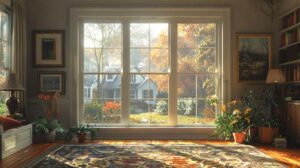Clean indoor air quality is vital for Northern Virginia homeowners, as indoor pollutant levels typically measure 2-5 times higher than outdoor concentrations. Common contaminants include VOCs from cleaning products, formaldehyde from building materials, and accumulated household dust. These pollutants can trigger respiratory issues, allergies, and impact cognitive performance. Professional HVAC maintenance, advanced air purification systems like HEPA filtration, and proper ventilation strategies are essential for maintaining healthy indoor environments. Regular air quality management, including humidity control and contamination prevention, helps protect residents’ health while reducing long-term medical expenses. Understanding the full scope of indoor air quality solutions can maximize your home’s health potential.
Key Takeaways
- Northern Virginia’s seasonal climate changes require effective indoor air management to prevent allergen accumulation and respiratory issues.
- Indoor air pollution levels can be 2-5 times higher than outdoor levels, making air purification essential for homeowner health.
- Regular HVAC maintenance by NATE-certified technicians can improve system efficiency by 15% and extend equipment lifespan significantly.
- Modern air purification systems with HEPA filters capture 99.97% of airborne contaminants, protecting families from harmful pollutants.
- Proper humidity control and ventilation prevent mold growth, particularly during Virginia’s humid summer months.
Understanding Indoor Air Pollution Risks
While many Northern Virginia residents focus on outdoor air pollution, indoor air quality presents a more significant health concern, with pollutant levels typically reaching 2 to 5 times higher than exterior concentrations. This increased exposure stems from multiple sources within residential environments, creating a complex matrix of contaminants that affect respiratory health and overall well-being.
Poor indoor air quality often results from the accumulation of volatile organic compounds (VOCs) emitted by common cleaning products, building materials containing formaldehyde, and the significant buildup of household dust, which can amount to 40 pounds annually. The presence of mold spores in damp areas compounds these issues, potentially triggering allergic reactions and respiratory complications in sensitive individuals.
Furthermore, the interaction between indoor and outdoor pollutants creates additional challenges. When exterior contaminants such as pollen and smoke infiltrate homes, they combine with existing indoor pollutants, intensifying air quality concerns. This combination of factors necessitates a comprehensive understanding of indoor air pollution sources and their potential health impacts to effectively address air quality issues in Northern Virginia residences.
Health Benefits of Clean Air
The compelling evidence for maintaining clean indoor air quality extends far beyond pollution prevention to encompass significant health advantages for Northern Virginia residents. Research demonstrates that households implementing effective cleaning and air purification strategies experience markedly reduced exposure to common allergens, including dust, pet dander, and mold spores, resulting in fewer respiratory complications.
Regular maintenance of HVAC systems coupled with the strategic placement of air purifiers yields measurable improvements in respiratory health outcomes. Studies indicate that proper air filtration can make indoor environments 2-5 times less toxic than outside conditions, significantly benefiting vulnerable populations such as children and elderly residents. The quality of the air directly influences cognitive performance, with cleaner air correlating to improved mental clarity and increased productivity levels.
Furthermore, investment in air quality management through proper HVAC system maintenance and air purification technologies represents a cost-effective approach to healthcare. Households maintaining ideal indoor air quality typically experience reduced medical expenses related to respiratory conditions, particularly among family members with asthma or similar sensitivities, while creating a healthier living environment for all occupants.

Modern Air Purification Solutions
Modern air purification technology‘s rapid advancement has transformed indoor air quality management for Northern Virginia homeowners. Whole-house HEPA air filters now deliver exceptional performance, capturing up to 99.97% of airborne contaminants, including microscopic particles that conventional filtration systems miss. These modern air purification solutions provide comprehensive protection against common indoor pollutants, allergens, and pathogens.
Advanced systems like Aerus ActivePure® Technology air scrubbers actively combat indoor air pollution, effectively eliminating mold and mildew, cigarette smoke, and other persistent contaminants. The integration of UV light technology in contemporary purification systems adds another layer of protection by destroying harmful microorganisms at the DNA level, ensuring a healthier indoor environment.
Humidity control plays an essential role in modern air quality management. Whole-house humidifiers maintain ideal moisture levels during dry periods, while dehumidification systems prevent excess moisture accumulation that could lead to mold growth. This balanced approach to moisture management, combined with advanced filtration and UV sanitization, creates a comprehensive air quality solution that addresses multiple aspects of indoor air pollution, providing Northern Virginia residents with cleaner, healthier air throughout their homes.
Professional HVAC Maintenance Tips
Maintaining ideal indoor air quality through professional HVAC system care represents a critical investment for Northern Virginia homeowners. NATE-certified technicians performing bi-annual maintenance can improve system efficiency by up to 15% while identifying potential air quality hazards, including mold growth within ductwork that could compromise respiratory health.
Professional maintenance protocols encompass comprehensive system inspections, filter replacements, and strategic duct cleaning every 2-3 years. These measures effectively control humidity levels and reduce airborne contaminants, guaranteeing peak system performance while extending equipment lifespan by 5-10 years. Regular maintenance also prevents the accumulation of allergens and particulates that can deteriorate indoor air quality.
Implementing a structured maintenance schedule, particularly before peak heating and cooling seasons, proves essential for preventing emergency repairs and maintaining consistent air quality throughout the year. Professional technicians utilize advanced diagnostic tools to detect hidden sources of contamination within HVAC systems, addressing potential issues before they impact indoor air quality. This proactive approach not only safeguards system efficiency but also guarantees Northern Virginia residents maintain healthy indoor environments through properly maintained HVAC equipment.
Common Household Contaminant Sources
Multiple everyday sources within Northern Virginia homes contribute significantly to indoor air contamination, often creating pollution levels that exceed outdoor concentrations by up to five times. Regular household activities introduce substantial pollutants into the air inside, with cleaning products releasing volatile organic compounds (VOCs) that compromise air quality. Modern building materials, particularly pressed wood products commonly used in recent construction and renovations, emit formaldehyde and other harmful substances.
The air in your home faces additional challenges from routine activities like cooking and bathing, which generate smoke, steam, and excess moisture. Pet ownership introduces another layer of indoor air pollution through accumulated dander and hair, while dust mites thrive in these environments. In addition, the presence of pets can lead to allergen buildup in air ducts, potentially exacerbating respiratory conditions.
External pollutants, including pollen and atmospheric particulates, readily enter homes through windows, doors, and ventilation systems. This infiltration, combined with internal contaminant sources, creates a complex mix of pollutants that can significantly impact indoor air quality, making proper ventilation and filtration essential for maintaining healthy living spaces in Northern Virginia residences.
Smart Ventilation Management Strategies
Three fundamental ventilation management strategies can effectively combat indoor air pollution in Northern Virginia homes when implemented systematically. Mechanical ventilation systems improve air exchange rates, facilitating the continuous circulation of fresh air while efficiently removing indoor pollutants. These systems can maintain indoor air quality at levels that are 2-5 times superior to outdoor environments, as documented by EPA research.
Natural ventilation through strategic window placement serves as a complementary approach, allowing outdoor air to dilute harmful indoor pollutants. This method is particularly effective when coordinated with peak outdoor air quality periods, maximizing the benefits of air exchange. Additionally, implementing humidity control measures, including regular monitoring with hygrometers, is essential for maintaining levels below 60%.
The integration of these ventilation strategies creates a comprehensive approach to air quality management. When mechanical systems work in conjunction with natural ventilation and humidity control, homeowners can achieve ideal indoor air conditions. This systematic approach not only reduces contaminant concentrations but also promotes a healthier living environment through consistent air exchange and moisture regulation.
Frequently Asked Questions
Why Is It Important to Have Good Indoor Air Quality?
Maintaining good indoor air quality is critical for human health and well-being. With individuals spending approximately 90% of their time indoors, exposure to pollutant levels 2-5 times higher than outdoor concentrations can significantly impact respiratory health, cognitive function, and overall wellness. Poor indoor air quality can lead to respiratory infections, allergic reactions, and other health complications. Effective air quality management through proper ventilation and filtration is essential for creating healthy indoor environments.
What Is the Air Quality in Northern Virginia?
Like a hidden storm brewing indoors, Northern Virginia’s indoor air quality presents significant challenges. EPA studies indicate indoor air can be 2-5 times more polluted than outdoor air in this region. The area experiences seasonal variations, with spring bringing heightened pollen levels and summer humidity fostering mold growth. VOCs from household products, combined with common pollutants and inadequate ventilation, contribute to compromised air quality in Northern Virginia homes.
Why Is Clean Air Quality Important?
Clean air quality is vital for human health and well-being as it directly impacts respiratory function and overall physiological health. Studies indicate that poor air quality can lead to immediate and long-term health complications, including respiratory infections, cardiovascular diseases, and exacerbation of existing conditions like asthma. With Americans spending approximately 90% of their time indoors, where pollutant concentrations can be significantly higher than outdoor levels, maintaining clean air is essential for preventing health-related issues and ensuring ideal indoor environmental quality.
Why Is Indoor Air Quality Monitoring Important?
Indoor air quality monitoring is essential for detecting and managing harmful pollutants that can be 2-5 times more concentrated indoors than outdoors. Continuous monitoring enables early identification of contaminants such as mold spores, VOCs, and particulate matter, allowing for prompt intervention. This proactive approach helps maintain ideal humidity levels, guarantees HVAC system efficiency, and protects occupant health, particularly given that people spend approximately 90% of their time indoors.






2 Responses